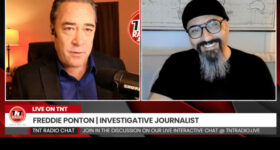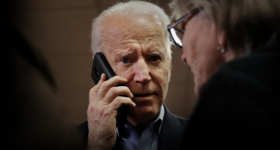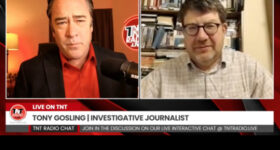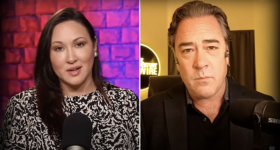Shawn Helton
21st Century Wire
The tragic death of Kurt Cobain has mystified the public for more than two decades and over that time, many questionable forensic elements have come to light surrounding the singer’s sudden end.
Throughout the course of this article, we’ll explore some of the main reasons why the Cobain case should be reopened…

‘ICONIC’ – Kurt Cobain in studio during a Nirvana recording session. (Photo pinterest)
Since the release of the feature film Soaked In Bleach (SIB) this past summer, interest in the suspicious nature of Cobain’s death has dramatically increased. As previously mentioned here at 21WIRE, much of the case details used in film were gleaned from former L.A. County Sheriff’s Detective and veteran private investigator Tom Grant.
SIB depicts much of Grant’s personal investigation into Cobain’s sudden untimely end over 20 years ago. The film also presents analysis from several notable forensic experts, as gripping real-life audio recordings are threaded throughout the motion picture – lending authenticity to the film’s claims.
It’s important to remember that there were many ‘copycat suicides’ in the wake of Cobain’s death and at least 68 documented cases have been attributed to the manner in which the singer had reportedly died.

‘PATCHWORK’ – Courtney Love with her daughter Frances Bean Cobain promoting Montage of Heck at the Sundance Film Festival early in 2015. In September, Frances reportedly married her longtime partner Isaiah Silva – Love was not in attendance. (Photo independent)
Prior to SIB’s release, HBO co-produced the Courtney Love-endorsed documentary Kurt Cobain: Montage of Heck (MOH) this past May. The visually fragmented film was directed by one of Hollywood’s dutiful documentary filmmakers, Brett Morgen.
As we’ve discussed at 21WIRE before, Morgen cemented his legacy by crafting a heavy-handed portrait about the Hollywood producer, Robert Evans, in a ‘documentary’ called The Kid Stays in The Picture (2002).
In an interview with Filmmaker Magazine from 2002, Morgen revealed his personal perspective on documentary filmmaking with the following comment:
“We can go through 10 of the great non-fiction films of the last 10 years – there’s nothing objective about any of them. Do they acknowledge it? No. They’re doing what the dominant cinema does, which is to present the illusion of truth.”
Although the ‘authorized’ documentary-drama MOH, had been billed as a celebration of Cobain by its creators, the film appeared to be laced with what seemed to be heavy speculative commentary and well-edited emotionally charged interviews – all focusing on Cobain’s perceived ‘suicidal’ tendencies – without ever questioning, or even mentioning the troubling forensic details surrounding his death.
As Cobain’s life and death have been thrust back into the spotlight, its worth taking another look at some of the primary reasons why this case should be reinvestigated.
Here’s our list in a count down to number one…

‘CRIME SCENE’ – Cobain’s body was discovered on April 8th, 1994 in the greenhouse shown above. (Photo seattlepi)
5. False Reports & the ‘Suicidal Myth’ – There were many misleading media reports in the wake of Kurt Cobain’s tragic death in April of 1994. Perhaps the most eye-opening of them, was that Cobain’s mother, Wendy O’Connor, had filed a missing-person’s report on April 4th, claiming that her son had recently fled from drug rehab in Marina Del Ray on April 1st, flown back to Seattle, purchased a shotgun and “may be suicidal.”
As it turned out, the missing-person’s report was in fact filed by Love, as she used her mother-in-law’s name to file a report about her missing husband.
Love would later admit she filed the report impersonating O’ Connor, which has led some critics of the case to believe that her assertions about her husband’s state of mind were only a red herring for the authorities and media alike.
It’s been long-established that Cobain legally obtained the shotgun for personal protection before going to a non-lockdown rehab facility in late March of 1994. And the (April 4th) false police report dovetailed a widely publicized disturbance call made by Love from the Cobain residence at Lake Washington on March 18th, 1994.
Both the Seattle Post-Intelligencer newspaper and Associated Press published articles on April 9th – the day after the singer’s body was discovered in the greenhouse above his garage, stating that “Cobain was coaxed from the room and said he didn’t want to hurt himself, ” on a March 18th police call to the singer’s house.
This aspect of the story was central in validating the idea that the rock icon was already on a ‘downward spiral’ making the public acceptance of his apparent suicide a fait accompli.
As reported previously at 21WIRE, a story first published at the website Cobaincase, revealed an entirely new set of details regarding the infamous March 18th 911 call.
The details regarding the March 18th incident would greatly influence public perception about Cobain’s apparent mental state, as it marked the first of two official reports that Love would make to the Seattle Police Department in under a month – falsely claiming Cobain was ‘suicidal’with a gun.
According to the exclusive story from the Boston-based investigative journalist Matthew Richer, a more complete version of the March 18th disturbance call was unearthed when he contacted Seattle Police Department Detective Everett Edwards for an interview.
Detective Edwards is recognized throughout the Seattle community and has been a well-respected veteran of the police force for over 21 years.
He was the first patrol officer on the scene at Lake Washington that fateful evening on March 18th, 1994.
According Richer’s exclusive findings with Edwards, the officer arrived on the scene to discover Love on the front porch of the rock couple’s house screaming that Cobain was locked inside a room with gun and that “He’s gonna f***ing kill himself!” Edwards then explained he would have to wait for backup, prompting Love to respond with the following,“Well, if you’re not gonna do anything, then just get the f*** out of here!”
Richer’s article outlined the sequence of events during the March 18th police call, as relayed by Edwards:
“We were always led to believe that the police encountered an armed Kurt Cobain locked inside a room in his house that night.”
“According to Detective Everett Edwards, the reality is that Kurt Cobain was not inside the house at all when the police arrived that day.”
“Instead, when Edwards and his partner attempted to enter the house through the backdoor, they discovered an unarmed Kurt Cobain sheepishly standing in the backyard with his hands in his pockets.”
Additionally, Edwards disclosed that Cobain ‘calmly’ walked with the officer to sit in the backseat of his squad car to discuss the circumstances of the disturbance call. Recounting the events of that evening, Edwards recollected, “He [Cobain] was just a very, very nice guy,” and did not appear to be under the influence of any drugs.
Also, according to Richer’s interview with Edwards, Cobain acknowledged to authorities that he had “simply locked himself in a room after an argument, ” and had no intention of harming himself.
Although much was made of the March 18th police visit after Cobain’s death, the ‘disturbance call’ looks to have been a significant factor in painting a specific point of view prior to singer’s unexpected end.
Here is an excerpt from the original police report, providing further confirmation that Cobain’s actions were misrepresented during the March 18th incident:
“After further interviewing Ms. Love, she stated that she did not see him with a gun, and he did not say he was going to kill himself.”
Given the suspicious nature of the missing-person’s report filed with the Seattle Police Department (SPD), and the misrepresentation of Cobain’s mental state on the evening of March 18th – it should be acknowledged that the media has played a rather large role in distorting the public’s perception following the singer’s shocking death over twenty years ago.

‘DARK ROMANCE’ – Cobain and Love’s infamous stay at Rome’s Excelsior Hotel. (Photo pinterest)
4. The Nightmare in Rome & an Accidental Overdose – On March 4th, 1994, Kurt Cobain fell into a 20 hour coma in the morning hours after ‘allegedly’ ingesting some 50 rohypnol pills while drinking champagne at Rome’s Excelsior Hotel.
At the time, Love was stated as having a prescription to rohypnol and was in possession of the known sedative.
The drug rohypnol, also known as ‘Roffies’, is highly potent and has been used to incapacitate victims unknowingly. Often under the influence of the drug, a victim is unable to remember what happened to themselves, as it is odorless as well as tasteless, and cannot be detected when administered.
Over the years, many have wondered what really happened during Cobain’s stay in Rome…

‘GATEKEEPERS CLUB’ – Montage of Heck Director Brett Morgen has been promoting the newly released Cobain home recordings amidst a flurry of criticism and calls of exploitation regarding the Nirvana icon. (Photo clippings.me)
In an interview featured in The Daily Beast earlier this year, MOH filmmaker Brett Morgen, discussed his perspective of the Cobain overdose in Rome. Not surprisingly, Morgen’s assessment of the events in Rome and Cobain’s state of mind, became a tabloid-style rant bypassing truth in favor of fiction:
“He was brain dead after Rome,” says Morgen. “He didn’t create any more art, and he took 50 Rohypnol pills.”
Ironically, at the time of the incident, the attending doctor stated that Cobain had “no permanent damage,” according to Rolling Stone.
In fact, Nirvana manager Janet Billig, also confirmed Cobain would make a “full recovery,” in an L. A. Times piece from March 5th, 1994.
As we’ve noted before, according to Tom Grant’s case notes, the incident in Rome was not considered to be a suicide attempt by the doctor who treated Cobain in Rome. And during the course of MOH, Cobain’s Rome overdose was once again revised to fit the official narrative leading up to the singer’s death.
MOH, chose to exclude any credible accounts regarding the incident in Rome – reflecting a biased approach during the making of the film.
In a reveling interview featured in MOH, Love appeared to recount a new back story regarding the incident in Rome one that was previously unmentioned by the media.
According to the well-known songstress, Cobain was aware that Love had been ‘thinking about’ being unfaithful during the course of their marriage. It was strongly suggested that this new revelation contributed to Cobain’s apparent mental downfall in the days leading up to his death.
Curiously, this new revelation concerning the events in Rome, contradict what Love stated to the press at the time of Cobain’s overdose. And when speaking to Select Magazine shortly after Cobain’s drug-induced coma in Rome, Love confidently announced that the incident was “not a suicide thing.”
Additionally, Dr. Osvaldo Galleta, the attending doctor who treated Cobain, stated that the Rome overdose did not appear to be a suicide attempt by expressing the following:
“We can usually tell a suicide attempt, “He [Kurt Cobain] did not seem like a young man who wanted to end it all, ” confidently stating that Cobain, “will fully recover with no lingering problems.”
As you can see, Morgen and Love’s ‘montage’ of events concerning Rome, seem to differ quite a bit from reports at the time, including this Rolling Stone report by Neil Strauss:
“A note was found,” says Billig, “but Kurt insisted that it wasn’t a suicide note. He just took all of his and Courtney’s money and was going to run away and disappear.”
It’s important to remember, that the note from Rome – was later referenced as an ‘additional’ Cobain suicide note, which was destroyed by Love, as she was on record stating that former SPD Sgt. Don Cameron – told her to do so.
In a tape recorded conversation by Grant on April 3rd, 1994 regarding the contents of the Rome note, Love stated that “He [Cobain] claims he was leaving me.”
And prior to Cobain’s nightmare in Rome, there was another highly suspicious accidental overdose involving the Nirvana icon…
On May 2nd, 1993, police reports indicate Cobain had accidentally overdosed on heroin. While the well-known singer was incapacitated, there were a serious of questionable actions while he was being resuscitated – marking another mysterious aspect in the Cobain saga.
According to police reports obtained after a Freedom of Information Act request, Cobain had OD’d on $30-40 dollars worth of heroin on the evening of May 2nd, 1993.
Prior to the police report being publicly released, whole sections and even an entire paragraph was redacted. It was later learned that Love ‘forcibly’ administered a host of drugs (Buprenorphine, Valium and Codeine based Tylenol) that would have only intensified the Nirvana star’s “total opiate threshold,” during the health crisis.
Over the years, Love has asserted that she was trying to revive Cobain prior to paramedics arriving on scene. Although Love has never been charged with any wrongdoing, some close to the case suspect that her ‘friendship’ with Narcotics Detective Antonio Terry, of the Seattle Police Department may have played a role in her avoiding any culpability for her alleged actions.
It’s important to reiterate, that Detective Terry was the point of contact on the misleading missing-person’s report from April 4th, 1994. Terry later died some two months after Cobain’s death in an unrelated incident during a traffic stop.
The untimely set of circumstances which lead to Terry’s death are described here on the Officer Down Memorial Page.
As outlined above, the Rome overdose appeared to be anything but a ‘suicide’ attempt, prompting many to wonder what really transpired at the time. Additionally, Love’s alleged actions following Cobain’s accidental overdose in May of 1993, should be reexamined – should this case get reopened.
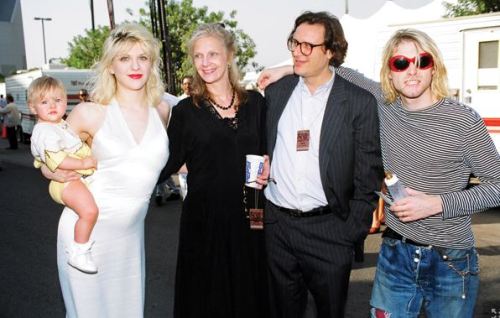
‘STARRY EYES’ – Rosemary Carroll and Danny Goldberg with Cobain, Love and their daughter Frances. (Photo tumblr)
3. Tales of Divorce & Talk of Money
In 1992, Love agreed to sign a prenuptial agreement prior to marrying Cobain, which could have made a larger financial outcome more difficult for the rock siren.
It has long been established that Cobain was in the process of divorcing Love prior to his death. In addition to the start of what would have been a very high-profile Hollywood divorce, Cobain was also said to have been working on finalizing his will before his sudden end.
Another extremely important disclosure took place during a taped conversation between Rosemary Carroll (Cobain and Love’s entertainment attorney at the time) and Grant in the week following Cobain’s death, was that Carroll stated that she never believed the apparent suicide note found near Cobain’s body was completely written by the singer – or that he was suicidal at all.
Grant has asserted for years, that it was Carroll who spurred a more in-depth investigation into the death of the Nirvana star.
Back in 1994, the Nirvana front man turned down a $9.5 million dollar contract to play the popular music festival Lollapalooza. This is said to have contributed to tension between the well-known ‘grunge’ couple, as Love was apparently upset that Cobain turned down the large concert deal and in the process – offered up her own band Hole as a replacement.
According to Everett True‘s Nirvana: The biography, “On April 6th, Lollapalooza organizer Ted Gardner issued a press release, officially confirming that Nirvana would no longer be headlining the festival, “ just two days before the singer’s body was discovered.
In 2001, the L.A. Times reported that Nirvana generated “an estimated $500 million in retail sales worldwide since its first release in 1990.”
According to a CNBC report in 2014 the value of the Cobain estate had been recently assessed:
“The brand of Kurt Cobain—his estate was recently valued at $450 million—is clearly big business.
The financial component regarding Nirvana, Cobain and Love, has always been the elephant in the room, as well as the fact that the well-known singer had sought to change his will during what most likely would have been a very high-profile divorce.
In addition to the potential financial motive concerning Cobain’s spouse, there is the matter of the couple’s live-in-nanny, Love’s close friend and former lover, Michael Dewitt (aka Cali) who reportedly received $30,000 dollars some time after Cobain’s death to go to a rehab treatment facility.
According to case notes, Cali was missing from the property sometime between April 2nd-5th but was at the property on the 6th. He was never subjected to a polygraph or treated as a suspect by police and had only one phone interview following Cobain’s death.
Another ‘person of interest’ who was recently questioned regrading Cobain’s final days, was Cali’s former girlfriend at the time, Jessica Hopper – also one of the last people to see Cobain alive. Incidentally, there have been some interesting questions posed, concerning the couple’s whereabouts and the timeline of events at the Lake Washington property in the days leading up to the discovery of Cobain’s body.
Below is an audio recording from a Q & A session featuring Pitchfork Magazine editor Jessica Hopper on a recent book tour in Dublin. Listen as a reporter asks a question concerning Cobain on the morning of April 2nd, 1994…
Both Hopper and Dewitt are stated as leaving Washington State prior to Cobain’s body being discovered and they were believed to be the only other people staying at Cobain’s property.
In conclusion, we must consider the rather obvious financial aspect concerning Cobain’s death – while also reevaluating the murky circumstances surrounding both occupants at the Lake Washington residence who subsequently fled the area before the grisly discovery of the Nirvana singer’s body.

‘SETTING UP THE SCENE’ – A crime scene photo of Cobain’s belongings near his body. Authorities pulled Cobain’s picture out of his wallet prior to taking this photograph. (Photo blurtonline)
2. Death Scene Investigation
One of the most perplexing aspects of the Cobain case, was that the cause of death was established before detectives had arrived on the scene. In fact, Seattle authorities listed it as a ‘typical suicide’ from the onset, strongly setting the tone for how it would be viewed by the authorities, the public and media from that point forward.
During the eye-opening documentary SIB, former NYPD Homicide Detective Vernon Geberth, also weighed in on the Cobain case. While discussing case details, he revealed that he has personally reviewed over “eight thousand homicides,“ in addition to writing the standardized book on police procedures for death investigations entitled, Practical Homicide Investigation.
In an article written by Geberth, originally published by Law & Order Magazine, we see an outline of “The Seven Major Mistakes in Suicide Investigation.” The educational article reveals some of the more common errors made by law enforcement during a death scene investigation. The following is a passage from Geberth’s informative piece:
“As a homicide commander, I recommended that a detective respond to every unattended death scene, whether it was reported as a homicide, suicide, accident or natural to assure that any potential crime scene and/or evidence surrounding the event was NOT disturbed.”
Based on Geberth’s quote above, we know that the SPD did not follow police protocol while examining Cobain’s death scene and according to Geberth’s standardized book:
“All death inquiries should be conducted as homicide investigations until the facts prove differently. The resolution of the mode of death as Suicide is based on a series of factors which eliminate Homicide, Accident and Natural Causes of death.”
During the course of the feature SIB, former detective Geberth, also noted that every crime scene he has ever been involved with, “the photos were developed, “ while the investigation was still ongoing.
This procedural code of ethics, directly contradicted how the Seattle police handled their investigation into Cobain’s death.
In 2014, the SPD’s cold case division unearthed some four rolls of undeveloped film taken at Cobain’s death scene. The newly developed photos were quickly touted as definitive proof of the initial ‘suicide’ ruling in the case and promptly sent back to evidence storage.
On February 13th 1995, the SPD, was contacted regarding the ‘preservation and security’ of the Cobain case crime scene photos. At that time, Love’s attorney, Seth Lichtenstein “called and asked if the photos could be destroyed,” to allegedly prevent an unintended release. Rather interestingly, the SPD stated that the destruction of the photos would be “foolish and certainly unprofessional,” given Grant’s continued inquiry into the case.
The Cobain puzzle has continued to unravel…
Back in June, during 21WIRE‘s exclusive interview with SIB filmmaker Benjamin Statler, we discussed some of the most important forensic details in the Cobain case – and some of the main reasons why this case should be re-opened as a homicide investigation.
Below is another look at some of Statler’s revealing comments concerning the Cobain case:
“The blood morphine level. The positioning of the shotgun and expelled shell. The last four lines of the “suicide note” which seem like completely different handwriting from the body of the note.”
“The gross discrepancy between the actual facts of the case and what was reported and what continues to be reported by the media. Almost everything I was told by the media about Kurt’s death contradicted the facts.”
Where did this misinformation come from and why was it being planted in the media?”

‘NOTE AT THE SCENE’ – Note in red ink left in the greenhouse. (Photo beyondthewatch)
Another heavily debated aspect in the Cobain case, is the alleged suicide note left in the greenhouse where Cobain’s body was discovered.
The so-called suicide note penned in red, appeared to have been mostly written by Cobain. However, upon analyzing it closer, many handwriting experts have come to the conclusion that a small but significant portion of the ‘note’ at the end, indicated the possibility of someone else’s handwriting.
During SIB, the noted Forensic Document Examiner Heidi Harralson – stated that there was evidence of another hand at work on the bottom portion (the last 4 lines) of the apparent suicide note. And the most memorable examination of the note was done by world-renowned document examiner Reginald Alton of Oxford University, who also came to the conclusion that there was something amiss with the note, stating following:
“There are many indications that there could be a second hand at work.”
According Grant’s case notes, Carroll had discovered a handwriting practice sheet for forgery in Love’s bag shortly after Cobain was found dead.
The note at the scene coupled with anomalies related to the shotgun, such as positioning, the location of the expelled shell and the lack of legible prints on the firearm, have caused concern for many looking into the shocking details of this case. Additionally, apparently improper death scene investigation should also be looked into.

‘IN THE SPOTLIGHT’ – Kurt Cobain seen here at the Piper Club in Rome before a Nirvana performance. Another important aspect in the case revealed that there was suspicious activity on Cobain’s personal credit cards prior to his body being found. (Photo villagevoice)
1. Cobain’s Cause of Death
Many consider the analysis of Cobain’s heroin blood level the most significant element forensically, as evidence indicated that singer’s body had three times the lethal dose of heroin in his bloodstream prior to the use of the shotgun.
Expert testimony has stated that due to the amount of heroin in Cobain’s system, he could not have been able to perform the task of shooting himself as the immediate impact of the heroin would have left him incapacitated.
For years, a collection of authorities, experts and media, have argued over the amount of heroin in Cobain’s system, but in order for him to have registered a heroin blood level of 1.52 mg per liter three days after being deceased, he would have had to have had a much higher dose upon the time of injection.
When examining Cobain’s death scene, we see that the intravenous blood-morphine concentration of 1.52 mg’s per liter post-mortem, would have been three times the lethal dose of heroin in a severe user and significantly larger in the average person.
In March of 2014, Detective Mike Ciesynski from the SPD’s cold case division reviewed the Cobain case, concluding that the official ruling of ‘suicide’ should stand.
However, seemingly unbeknownst to Detective Ciesynski, while releasing an official SPD statement, he admitted that Cobain died from a lethal dose of heroin – something which directly contradicts the coroner’s report and Cobain’s death certificate.
The cold case review was an effort to prove the case was closed, but the detective’s comments raised even more doubt about the initial investigation and true nature of Cobain’s cause of death.
It should also be mentioned that Detective Ciesynski revealed that Cobain’s blood-morphine concentration was the highest ever recorded heroin overdose in King County, Washington.
To this day, the official death certificate documents contend that Cobain’s cause of death was from a ‘perforating’ shotgun wound to the head.
From the past to the present…
During the feature SIB, distinguished forensic pathologist,Dr. Cyril Wecht, a former President of the American Academy of Forensic Science weighed in on the Cobain case.
Having a career spanning decades, Wecht has overseen tens of thousands of autopsies and during the course of SIB, he along with former SPD Chief of Police Norm Stamper, a cast cloud doubt over the initial investigation into Cobain’s death.
The shocking testimony of both Wecht and Stamper will no doubt leave many others asking questions about the death of the Nirvana icon.
These are just some of the top reasons why authorities should take another look at the Cobain case…
READ MORE HOLLYWOOD NEWS AT: 21st Century Wire Hollywood Files





